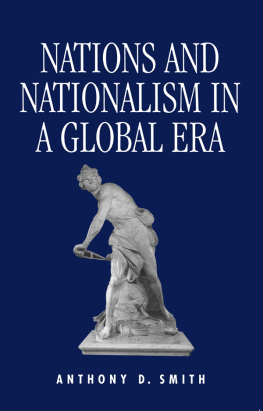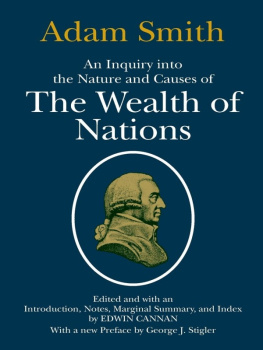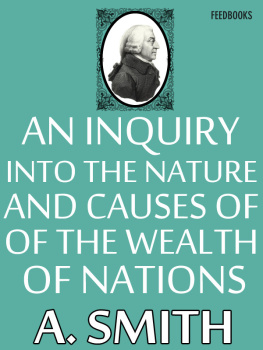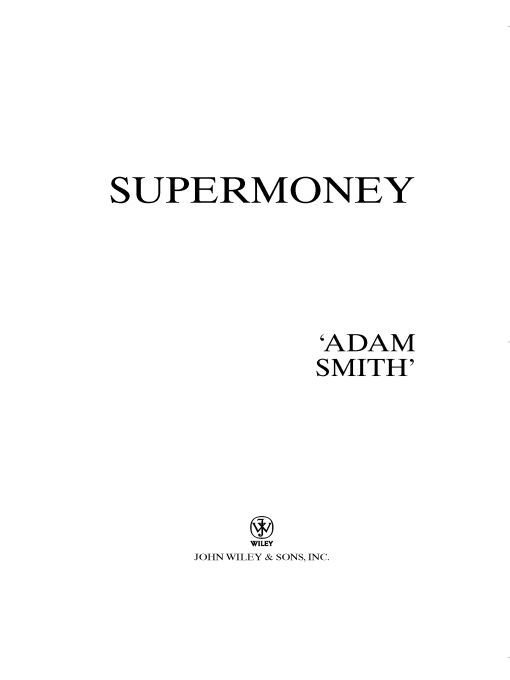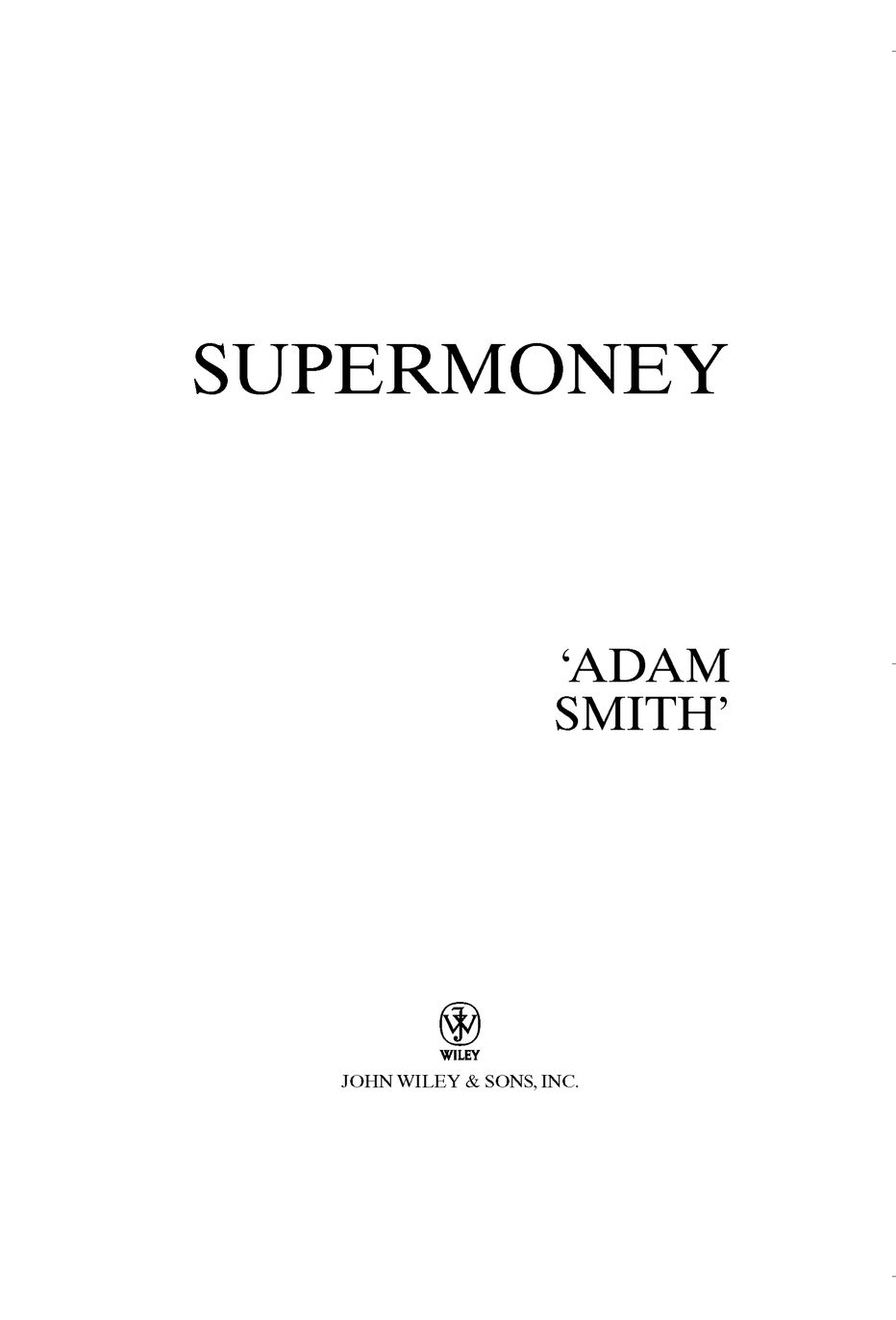Table of Contents
INTRODUCING WILEY INVESTMENT CLASSICS
There are certain books that have redefined the way we see the worlds of finance and investingbooks that deserve a place on every investors shelf. Wiley Investment Classics will introduce you to these memorable books, which are just as relevant and vital today as when they were first published. Open a Wiley Investment Classic and rediscover the proven strategies, market philosophies, and definitive techniques that continue to stand the test of time.
For Mark O. Park
and
Susannah B. Fish
FOREWORD
Supermoney, along with its predecessor, The Money Game, told the story of what came to be known as the Go-Go years in the U.S. stock market. It is the book that introduced Warren Buffett, now the worlds most noted investor, long before he became the paradigm of investment success and homespun financial wisdom. In Supermoney , author Adam Smith travels to Omaha to meet this Will Rogers character, and later brings him on his television show, Adam Smiths Money World. Buffetts distinction in the Go-Go era was that he was one of the few who divined it correctly, quietly dropping out and closing the investment fund he managed. His remaining interest, in a thinly traded New England textile company, Berkshire Hathaway, would later become the vehicle for what may well be the most successful investment program of all time.
The era of speculation described in The Money Gameand in Supermoneybegan in the early 1960s and was pretty much over by 1968, only to be succeeded by yet another wave of speculationalbeit one that was starkly different in its derivationthat drove the stock market ever higher through early 1973. Then the bubble of that era burst. By the autumn of 1974 the market had fallen by 50 percent from its high, taking it back below the level it reached in 1959, 15 years earlier.
Both books reached large, eager, and well-informed audiences, deservedly earning best-seller status. In them, the author Adam Smith recounted perceptive, bouncing, often hilarious anecdotes about the dramatis personae of the stage show that investing had become. While The Money Game was essentially a study in the behavior of individual investors, Supermoney, as its book jacket reminded us, was about the social behavior of institutional investors, focusing on the use of supercurrencyincome garnered through market appreciation and stock optionsthat became the coin of the realm during the Go-Go years.
These two books quickly became part of the lore of investing in that wild and crazy era. In retrospect, however, they provided Cassandra-like warnings about the next wild and crazy era, which would come, as it happens, some three decades later. The New Economy bubble of the late 1990s, followed by, yes, another 50 percent collapse in stock prices, had truly remarkable parallels with its earlier counterpart. Surely Santayana was right when he warned that those who cannot remember the past are condemned to repeat it.
In the aftermath of that second great crash, as investors again struggle to find their bearings, the timing of this new edition of Supermoney is inspired. It is a thoroughly enchanting history, laced with wit and wisdom that provides useful lessons for those investors who didnt live through the Go-Go years. It also provides poignant reminiscences for those who did live through them. Using the insightful (but probably apocryphal) words attributed to Yogi Berra, it is dj vu all over again.
I consider myself fortunate to have learned the lessons of the Supermoney bubble, albeit the hard way. While I was among those who lived and lost, both personally and professionally, in that era, I summoned the strength to return and fight again. Hardened in the crucible of that experience, I reshaped my ideas about sound investing. So as the New Economy bubble inflated to the bursting point in the years before the recent turn of the century, I was one of a handful of Cassandras, urging investors to avoid concentration in the high-tech stocks of the day, to diversify to the nth degree, and to allocate significant assets to, yes, bonds.
I also consider myself fortunate to have known and worked with Jerry Goodman (the present-day Adam Smith) during this long span, having been periodically interviewed for Institutional Investor magazine (of which he was founding editor) and for his popular Public Broadcasting Network television show, Adam Smiths Money World. We served together on the Advisory Council of the Economics Department of Princeton University during the 1970s, where his strong and well-founded opinions were a highlight of our annual roundtable discussions. While I have no hesitation in acknowledging Jerrys superior mind and writing skilla nice combination!I console myself with our parity on the fields of combat. (Exact parity: Years ago, on a Princeton squash court, we were tied at 2-2 in the match and at 7-7 in the deciding game when the lights went out and the match ended.)
As one of a very few participants who has been part of the march of the financial markets during a period that has now reached 55 yearsincluding both the Go-Go bubble of yore and the New Economy bubble of recent memoryIm honored and delighted to contribute the foreword to this 2006 reissue of a remarkable book. Ill first discuss the excesses of the Supermoney era; next, the relentless retribution that came in its aftermath; and finally, the coming and going of yet the most recent example of the extraordinarily popular delusions and the madness of crowds that have punctuated the financial markets all through history. Of course, if tomorrows investors actually learn from the hard-won experience of their elders and the lessons of history chronicled in this wonderful volume, there will never be another bubble. But I wouldnt count on it!
Part One: The Supermoney Era
The Goodman books chronicled an era that verged onand sometimes even crossed the line intofinancial insanity: the triumph of perception over reality, of the transitory illusion of earnings (to say nothing of earnings calculations and earnings expectations) over the ultimate fundamentals of balance sheets and discounted cash flows. It was an era in which investors considered concepts and trends as the touchstones of investing, easily able to rationalize them, since they were backed by numbers, however dubious their provenance. As Goodman writes in his introduction to this new edition:... people viewed financial matters as rational, because the game was measured in numbers, and numbers are finite and definitive.
During the Money Game/Supermoney era, perception was able to overwhelm reality in large measure because of financial trickery that made reality appear much better than it was. Adam Smith described how easy it was to inflate corporate earnings: Decrease depreciation charges by changing from accelerated to straight line... change the valuation of your inventories... adjust the charges made for your pension fund... capitalize research instead of expensing it... defer the costs of a project until it brings in revenues... play with pooling and purchase (accounting)... all done with an eye on the stock, not on what might be considered economic reality. And the public accountants, sitting by in silence, let the game go on. The most respected accountant of the generation, Leonard Spacek, chairman emeritus of Arthur Andersen, was almost alone in speaking out against the financial engineering that had become commonplace: How my profession can tolerate such fiction and look the public in the eye is beyond my understanding... financial statements are a roulette wheel. His warning was not heeded.







